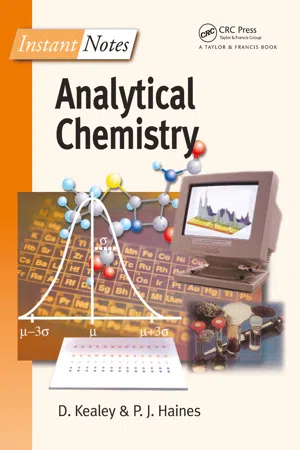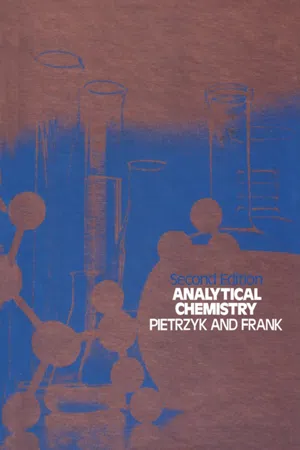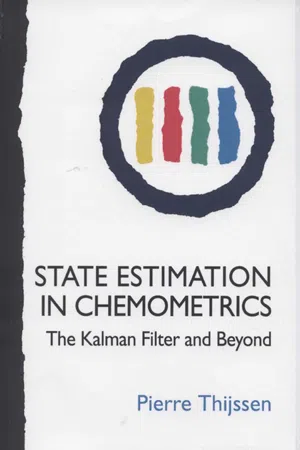Chemistry
Titrations
Titrations are a laboratory technique used to determine the concentration of a substance in a solution. This is achieved by reacting the substance of interest with a reagent of known concentration. The point at which the reaction is complete, known as the equivalence point, is used to calculate the concentration of the substance being analyzed.
Written by Perlego with AI-assistance
Related key terms
Related key terms
1 of 4
Related key terms
1 of 3
8 Key excerpts on "Titrations"
- Stig Pedersen-Bjergaard, Bente Gammelgaard, Trine G. Halvorsen(Authors)
- 2019(Publication Date)
- Wiley(Publisher)
5 Titration- 5.1 Introduction
- 5.2 Potentiometric Titration and Electrodes
- 5.3 Aqueous Acid–Base Titrations
- 5.4 Titration in Non‐aqueous Solvents
- 5.5 Redox Titrations
- 5.6 Alternative Principles of Titration
5.1 Introduction
Titration is a quantitative technique and methods based on titration provide high accuracy (99.5–100.5%) and precision (<0.5% relative standard deviation (RSD )). Titration is an official method in the European Pharmacopoeia (Ph. Eur. ) and in the United States Pharmacopoeia (USP ). In pharmaceutical analysis, titration is mainly used for quantitative analysis (assay) of active pharmaceutical ingredient s (API s) and excipients with the purpose of assessing the purity of a given substance (analyte).Titrations are based on measurement of volumes. An accurate amount of analyte is dissolved in a specific volume of solution. This solution is termed the titrate. Increments of a standardized solution of a reagent are added gradually until the entire amount of analyte has reacted. The standardized solution is termed the titrant. The concentration and exact volume of titrant added are used to calculate the amount of analyte. More generally, a titration can be described by the following titration equation:(5.1)Here x and y are the number of mol of analyte (pharmaceutical compound) and titrant involved to complete the titration. The titration is completed when all the analyte has reacted and transformed to products. The titration has then reached the equivalence point.The titrant is added either manually from a burette (see Figure 5.1 ) or automatically from an automatic titration apparatus termed an automatic burette or titrator.Figure 5.1Schematic view of the burette used for titrationDetection of the equivalence point can be based on visual inspection of colour change (Indicator detection) or based on electrochemical measurements (Potentiometric endpoint detection). In the latter case, the titration is often termed Potentiometric titration- eBook - ePub
- Justin P. Lomont, Ian C. Stewart(Authors)
- 2013(Publication Date)
- Visible Ink Press(Publisher)
The numerical value we read for the volume of liquid contained in this cylinder will depend on what part of the meniscus we choose to look at. Graduated cylinders and other containers are calibrated such that we should get the most accurate reading by looking at the center of the meniscus from eye level. If we don’t look at the meniscus from eye level, something called parallax error will occur that will distort our perception of level of the meniscus.What is a titration?A titration is a laboratory technique used to determine the concentration of a species in a solution. This is achieved by adding a second species of a known concentration (the titrant) that will react with the species whose concentration is to be determined (the analyte). There must be some indication of when the titration is complete, or, in other words, there must be some indication of when the unknown species has reacted completely with the titrant. A common example is the titration of a base by an acid. In these cases, a small amount of a pH-sensitive colored indicator can be added, and the end of the titration can be determined by observing a sudden large change in pH via a change in the color of the solution.What is an aqueous solution?An aqueous solution is any solution in which water is the solvent. This term is used pretty frequently in chemistry, so it’s good to be familiar with it.What is a “standard state”?A standard state is a set of reference conditions with respect to which properties can be described/calculated under other conditions. For example, the properties at standard-state conditions of a gas may be defined by its properties at 293.15 K and 1 bar of pressure. Knowledge of the properties of a gas under these standard conditions can be used to calculate the properties under other conditions.What is a chemical indicator?As we mentioned, for a titration to be successful there must be some indication of when it has finished. Chemical indicators are a common way of determining whether a titration is complete. In acid–base Titrations, chemical indicators are typically small molecules whose colors change depending on the pH of the solution (or, in other words, on their protonation state). In other cases, the indicator may change color based on whether it is coordinated to another species in a solution. It is also possible to use a device like a pH-sensitive electrode to determine when the titration has ended; this doesn’t rely on you (or another person) being able to notice a visible change in the color of the solution. Such a device can be more accurate, since it doesn’t rely on a qualitative interpretation of a color change. - eBook - ePub
Understanding Experimental Planning for Advanced Level Chemistry
The Learner's Approach
- Kim Seng Chan, Jeanne Tan(Authors)
- 2015(Publication Date)
- WSPC(Publisher)
CHAPTER 1 PLANNING USING TITRATIONTitration refers to a general class of experiments in which the known property (e.g., concentration) of a solution is used to infer the unknown property of another solution. A typical titration experiment requires the following apparatus:—Pipette and pipette filler to measure the volume of the analyte or titrand; —Burette to contain the standard solution or titrant; —Conical flask to contain the analyte or titrand; —Volumetric flask to make a standard solution or for carrying out a dilution; and —An indicator (optional) such as phenolphthalein, methyl orange, starch, etc. to signal the end of a titration. A titration set-up is shown as follows:Q What is a standard solution? A: A standard solution refers to one in which its concentration is already known accurately. Since the concentration of the solution is already known, when we used a certain volume of this standard solution, we would know the number of moles of particles that is used. Hence, we can make use of this information about the number of moles to determine the number of moles of reactants in the analyte, through a balanced chemical equation.Q Why is a burette used to hold the standard solution? A: A burette can measure up to two decimal places of accuracy while a pipette can only measure up to one decimal place of accuracy. Since a burette is more accurate than a pipette, it is usually used to contain the standard solution. But take note that there are exceptions in which a burette can be used to contain the non-standard solution that is used during titration. For such instances, there are usually other specific reasons for doing it.1.1Mixture of Potassium Hydrogen Carbonate and Potassium Chloride
The Task:A sample of potassium hydrogen carbonate, KHCO3 - eBook - ePub
- Steen Honoré Hansen, Stig Pedersen-Bjergaard, Knut Rasmussen(Authors)
- 2011(Publication Date)
- Wiley(Publisher)
Chapter 5 Titrimetric Methods5.1 IntroductionThis chapter discusses the principles of quantitative analysis based on titrimetric methods. Titrimetric methods are official methods in the European Pharmacopeia and are used for quality control of active pharmaceutical ingredients (APIs) and excipients. The chapter focuses on Titrations based on acid–base reactions and redox reactions and also gives an overview of various principles of endpoint detection. Examples of titrimetric methods for the quantitative determination of APIs and excipients are discussed in Chapter 21.In titrimetric methods the volume of a reagent needed to react with an analyte is normally measured. To the analyte solution are added increments of a reagent solution (titrant ) of a precisely known concentration until the reaction between the reagent and the analyte is complete. The titrant is added either manually from a burette (see Figure 5.1 ) or from an automatic titration apparatus , so that the volume of titrant is controlled at all times during the titration .A titrimetric reaction can be illustrated by the following equation:Figure 5.1 Burette used for titration(5.1)where x and y is the number of moles of analyte and titrant needed to complete the titration. Titration is finished when virtually all the analyte has reacted and is transferred to products. The titration has reached the equivalence point . The amount of reagent consumed is read on the burette, and the quantity of analyte in the sample solution can be calculated on the basis of knowledge of the values of x and y . An example of such a calculation is shown in Box 5.1.Box 5.1 Calculation of the concentration of analyte in a titrimetric methodA sample solution of H2 SO4 of unknown concentration was titrated with a solution of 1.056 M NaOH to determine the molar concentration of H2 SO4 . 25.00 ml of the sample solution was titrated to the equivalence point with 23.55 ml of NaOH solution. H2 SO4 - eBook - ePub
- David Kealey, P J Haines(Authors)
- 2004(Publication Date)
- Taylor & Francis(Publisher)
The theoretical amount of solution that must be added until the reaction is just complete is the equivalence point and the end point in a titration is the point at which change is detected accurately. In an ideal case, these points should be the same.In order to detect the end point, a visual indicator may be added. Instrumental methods may also be used.The use of an electrochemical cell with an indicator electrode and a reference electrode to measure the concentration at each stage in the titration facilitates the detection of the end point and the automation of Titrations.The major applications for acid-base reactions are the determination of the concentrations or amounts of acids or bases.Related topics
Other topics in this Section (C1-C4, C6-C10)Titrimetry
In order to obtain accurate quantitative data for a reaction in solution, it is necessary that the reaction be fast, complete and occur in fixed, reproducible amounts. The requirement for fast reaction is achieved readily when ionic species are involved, although in some other cases, it is necessary to warm the solutions or add a catalyst. The reaction will be complete provided the equilibrium constant is large (see Topic C1 ).The technique of volumetric analysis is the simplest type of titrimetry, and involves the addition of controlled volumes of a reagent solution, the titrant, to a known volume of another solution, the titrand in a volumetric titration. This procedure may be automated, and the changes detected instrumentally (Topics C2, C3, C9 and C10). In some cases, excess of a reagent is added and the excess measured by back titration.The volumes and concentrations can be measured with high accuracy. Calibration of volumetric glassware by discharge into weighed containers allows the determination of volumes to 0.01 cm3 . This corresponds to about 0.05% for a typical titration volume of 20 cm3 .Weighing solutes prior to dissolution gives comparable accuracy. Pre-determined volumes, for example 25 cm3 are measured with manual or mechanical pipets, while cumulative volumes of titrant during addition are measured by a manual or automated buret - eBook - ePub
Introduction to Soil Chemistry
Analysis and Instrumentation
- Alfred R. Conklin, Mark F. Vitha(Authors)
- 2013(Publication Date)
- Wiley(Publisher)
CHAPTER 10 Titrimetric Measurements10.1 Soil Titration10.1.1 Back Titration10.2 Titration of Soil pH10.3 Organic Matter10.4 Ammonia10.5 Kjeldahl: Organic Nitrogen10.6 Nitrite and Nitrate10.7 Carbonate Determination10.8 Halogen Ion Determination10.9 pH–Stat Titrations10.10 ConclusionsTitration is a general word used in many different disciplines. Any time a solution of known concentration is used to find the amount of an unknown component in another solution, it can be called a titration. Although this type of analysis is very old, it still finds widespread used in chemical analysis. Titrations are used in soil analysis to measure soil acidity, soil organic matter content, and various constituents isolated from soil, particularly ammonia.Common chemical Titrations include acid–base - eBook - ePub
- Clyde Frank(Author)
- 2012(Publication Date)
- Academic Press(Publisher)
Chapter FourteenPrecipitation Titrations
Publisher Summary
This chapter explains the definition of precipitation titration, in which a substance is titrated with a standard solution of a precipitating agent. At the completion of the precipitation, which is defined by stoichiometry of the reaction, either the appearance of excess titrant or the disappearance of the reactant is detected. Detection of the stoichiometric point is accomplished by color indicators as well as by instrumental methods. Of the latter, the principal technique is potentiometric measurement, which involves the usage of indicator or ion-selective type electrodes. The main difference between a precipitation titration and other volumetric methods is that a precipitate forms during the course of the titration. The titration requirements include the formation of a stoichiometric precipitate as well as those typical to most volumetric procedures. A stoichiometric relationship between the titrant and sample leading to precipitation is possible. Even though the precipitate is not isolated, the adsorptive nature of the precipitate toward the titrant leads to large errors.INTRODUCTION
A precipitation titration is one in which a substance is titrated with a standard solution of a precipitating agent. At the completion of the precipitation, which is defined by the stoichiometry of the reaction, either the appearance of excess titrant or the disappearance of the reactant is detected. Detection of the stoichiometric point can be accomplished by color indicators as well as by instrumental methods. Of the latter, the principal technique is potentiometric measurement using indicator or ion-selective type electrodes.The idea of a precipitation titration is a very old one. For example, Gay-Lussac in 1832 determined silver ion with chloride. Mohr and Volhard, whose names identify specific precipitation procedures involving silver ion and halides, made their contributions in 1856 and 1874, respectively. In the early 1900s the formation of turbidity (AgCl) in a titration procedure was successfully used to determine the atomic weight of silver, chlorine, and several metals isolated as pure metal chlorides. - eBook - ePub
State Estimation in Chemometrics
The Kalman Filter and Beyond
- Pierre C. Thijssen(Author)
- 2008(Publication Date)
- Woodhead Publishing(Publisher)
8The titration system
Publisher Summary
This chapter discusses the titration system. In titrimetry, unknown samples are evaluated by adding the titrant of a known concentration. The progress of the chemical reaction is indicated by a change of a suitable property such as a color, absorbance or potential. A state space model is designed to estimate in potentiometry the titration curve and its derivatives. From the estimated state, the set point and the inflection point can be evaluated offline. The discrete titration is investigated, where the titrant is delivered in discrete volume increments and the solution is allowed to equilibrate. The Kalman filter causes a systematic delay in the estimated state and so in the evaluated inflection point or set point, which is completely removed by subsequent fixed-interval smoothing. Implementation of the Kalman filter allows the online control of variable volume additions in order to obtain equidistant measurements. For continuous Titrations, the extension of the state space model based upon first-order dynamics is proposed. The Kalman filter allows the online control toward an empirically established endpoint in the titration curve. An attempt to estimate in a nonlinear fashion the exponential factor simultaneously with the titration curve and its derivatives was unsuccessful.In titrimetry unknown samples are evaluated by adding the titrant of a known concentration. The progress of the chemical reaction is indicated by a change of a suitable property such as a color, absorbance or potential. A state space model is designed to estimate in potentiometry the titration curve and its derivatives. From the estimated state the setpoint(s) and inflection point(s) can be evaluated offline.The discrete titration is investigated, where the titrant is delivered in discrete volume increments and the solution is allowed to equilibrate. The Kalman filter causes a systematic delay in the estimated state and so in the evaluated inflection point(s) or setpoint(s), which is completely removed by subsequent fixed-interval smoothing. Implementation of the Kalman filter allows the online control of variable volume additions in order to obtain equidistant measurements.
Index pages curate the most relevant extracts from our library of academic textbooks. They’ve been created using an in-house natural language model (NLM), each adding context and meaning to key research topics.
Explore more topic indexes
Explore more topic indexes
1 of 6
Explore more topic indexes
1 of 4







